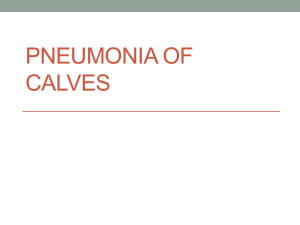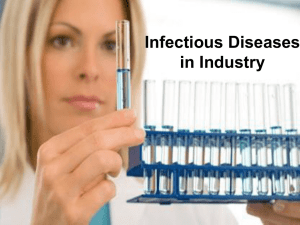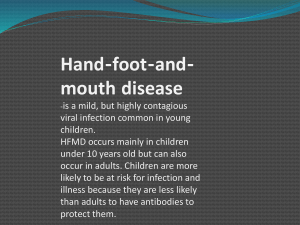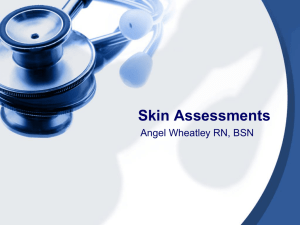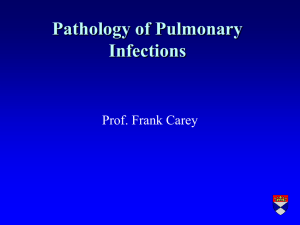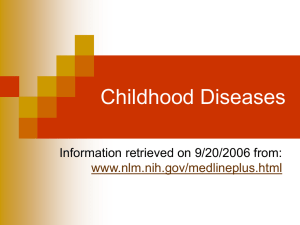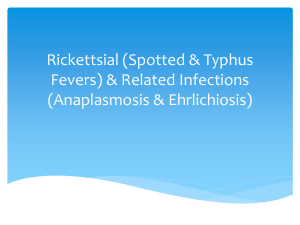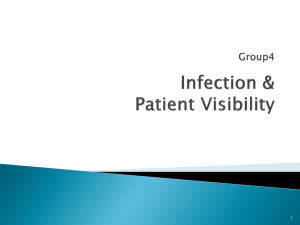Childhood Illnesses Slideshow!
advertisement
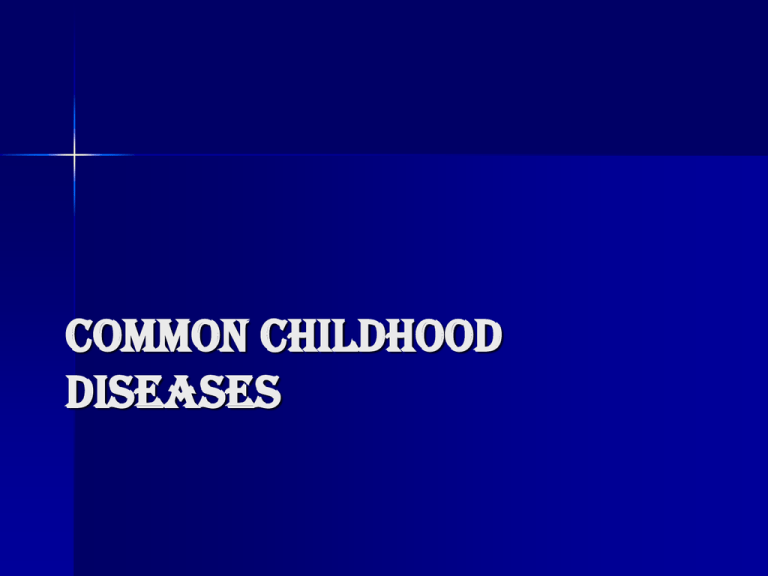
Common Childhood Diseases Chickenpox Incubation: It takes from 10-21, usually 14-16 days, after being exposed until symptoms develop. Contagious: From 1-2 days before the rash begins until blisters have become scabs. Exclusion: Until all the blisters have dried into scabs and no new blisters or sores have stared within the last 24 hours; usually 6 days after the rash begins. Conjunctivitis “Pinkeye” Incubation: It takes 1-12 days depending on the organism, usually 1-3 days, after exposure for symptoms to begin. Contagious: While symptoms are present. Exclusion: Usually no exclusion. However, if the student has a fever, eye pain, and pus contact your healthcare provider. Children with bacterial conjunctivitis are not to return to school before 24 hours after antibiotic therapy started. Click me! Croup Normal Airway Airway Causing Croup Duration: The symptoms of croup generally peak 2 to 3 days after the symptoms of infection start. Croup resulting from viral infection usually lasts less than a week. Complications: The vast majority of children recover from croup with no complications. Rarely, some children will develop complications such as ear infection or pneumonia. Prevention: Frequent hand washing and avoiding contact with people who have respiratory infections are the best ways to reduce the chance of spreading the viruses that cause croup. Fifth Disease Incubation: 4-21 days, usually 1-14 days from time of infection to onset of symptoms. Contagious: Most contagious before onset of rash, and is unlikely to be contagious after the rash begins. Exclusion: None, if other rash causing illness is ruled out y a healthcare provider; since persons with fifth disease are no longer infectious once the rash begins. Giardiasis Transmission: Contaminated water animal reservoir Symptoms: foul-smelling diarrhea, cramps, flatulence, fatty stools Complications: Severe malabsorption disease Pathogenesis: Cysts hatch after passage through stomach; trophozoites have sucking disks to attach to intestinal lining, resulting in malabsorption of nutrients Treatment: Quinacrine or metronidazole Hand, Foot, Mouth Disease HFMD is a mild illness that gets better in a few days, without any treatment. Antibiotics will not be any help in treating it because it is a virus. Do not give aspirin, or medications containing aspirin, to children under sixteen years old. You should encourage your child to drink plenty of fluids to reduce the chance of dehydration due to the high temperature. The spread of hand, foot and mouth disease can be reduced by frequent handwashing, putting your hand over your mouth when coughing and sneezing into a handkerchief or tissue. Haemophilus influenzae Mainly affects infants and children up to 5 years. Meningitis symptoms - generally unwell, fever, headache, vomiting, irritability, neck stiffness, refusing feeds, drowsiness, confusion, seizures, coma. Sensorineural hearing loss and neurodevelopmental disorders may result as sequelae of meningeal infection. Epiglottitis - rapid onset of fever and dyspnoea (breathing difficulty) progressing to dysphagia (difficulty swallowing), pooling of oral secretions and drooling of saliva. Affected individuals characteristically sit upright with their neck extended and tongue protruding to mitigate the effects of airway obstruction. Can also cause septic arthritis, cellulitis, pneumonia, septicaemia, osteomyelitis, bacteraemia and empyema in infants and young children. Individuals with septicaemia may develop gangrene requiring limb amputation. Disseminated intravascular coagulation may result from septicaemic shock Head Lice Don't use a hair dryer on your child's hair after applying any of the currently available scalp treatments, because some contain flammable ingredients. Don't use a cream rinse or shampoo/conditioner combination before applying lice medication. Don't wash your child's hair for 1 to 2 days after using a medicated treatment. Don't use sprays or hire a pest control company to try to get rid of the lice, as they can be harmful. Don't use the same medication more than three times on one person. If it doesn't seem to be working, your child's doctor may recommend another medication. Don't use more than one head lice medication at a time. Hepatitis A Follow good hygiene and avoid crowded, unhealthy living conditions. Take extra care, particularly when drinking and swimming, if you travel to areas of the world where sanitation is poor and water quality is uncertain. Never eat shellfish from waters contaminated by sewage. Remind everyone in your family to wash their hands thoroughly after using the toilet and before eating. Use antiseptic cleansers to clean any toilet, sink, pottychair, or bedpan used by someone in the family who develops hepatitis. Impetigo Incubation: 1-10 days from the time a person is exposed until symptoms develop. Contagious: Until sores are healed, or person has been treated with antibiotics for a full 24 hours. Exclusion: Until child has been treated with antibiotics for a full 24 hours. Neisseria meningitis • Incubation: This varies with the organism causing the meningitis. The incubation periods for the most common causes of meningitis range from 2 days to 2 weeks. • Duration: Even with proper treatment, bacterial meningitis may take days (and sometimes weeks) to resolve, and recovery from its effects may take even longer. Most cases of viral meningitis resolve completely within 1 to 2 weeks. Pinworms Remind your child to wash his or her hands after using the toilet, after playing outside, and before eating. Make sure your child showers or bathes every day and changes underwear daily. Keep your child's fingernails short and clean. Tell your child not to scratch around his or her bottom or bite his or her nails. Wash your child's pajamas every few days. Pneumonia Be Safe Vaccinate! Pneumonia • Incubation: The incubation period for pneumonia varies, depending on the type of virus or bacteria causing the infection. Some common incubation periods are: respiratory syncytial virus, 4 to 6 days; influenza, 18 to 72 hours. • Duration: With treatment, most types of bacterial pneumonia can be cured within 1 to 2 weeks. Viral pneumonia may last longer. Mycoplasmal pneumonia may take 4 to 6 weeks to resolve completely. • Contagiousness: The viruses and bacteria that cause pneumonia are contagious and are usually found in fluid from the mouth or nose of an infected person. Illness can spread when an infected person coughs or sneezes on a person, by sharing drinking glasses and eating utensils, and when a person touches the used tissues or handkerchiefs of an infected person. Scabies Doctors treat scabies by prescribing a medicated cream or lotion to kill the mites. The cream will need to be applied to the skin all over the body, not just the area with the rash, and usually must remain on the skin for 8 to 12 hours before it can be washed off. After applying it, don't wash your hands - scabies mites love the area between the fingers! You may want to apply the medication before your child goes to bed, then wash it off in the morning. Shingles Treatment with an antiviral can reduce the severity of the nerve damage and speed healing. If you suspect you have shingles, see your doctor within 72 hours of the first sign of the rash. While these treatments can reduce the symptoms of shingles, they are not a cure. The antivirals do weaken the virus and its effects, but the outbreak still tends to run its course. Strept Throat / scarlet fever Spread: Breathing in droplets from an infected person’s coughs and sneezes. Touching your mouth or nose after coming into contact with secretions. Incubation: symptoms. 2-5 days from exposure to onset of Contagious: begins. Until 24 hours after antibiotic treatment Exclusion: Until 24 hour after antibiotic treatment begins, and child is without fever for 24 hours. Scarlet Fever Thrush Most infants naturally have the yeast candida albican in their mouths. Because their immune systems are not yet mature, the amount of yeast in the mouth can overgrow and lead to an infection. (Adults and older kids who have weakened immune systems because of an illness or something like chemotherapy also can get oral thrush.) Oral thrush usually occurs within the first 6 months of life, and a baby with the infection will develop cracked skin in the corners of the mouth, and whitish or yellowish patches on the lips, tongue, or inside the cheeks.


